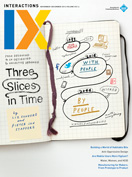Authors:
Tuomo Kujala, Geehyuk Lee, Hwanyong Lee, Youn-kyung Lim
In 1990, a research group at the KAIST Center for AI Research (CAIR) organized a special interest group for HCI in the Korean Institute of Information Scientists and Engineers (KIISE). KIISE SIGHCI continued to expand its membership, and in 2005 became an independent organization, the HCI Society of Korea (HCI Korea), with members from diverse HCI-related areas such as industrial design, human factors, architecture, art, sociology, and psychology. As the largest HCI academic society in Korea, HCI Korea is now carrying forward a variety of projects to promote HCI research and education in Korea and to foster cooperation with other domestic and international HCI societies.
The greatest of the HCI Korea projects is the HCI Korea conference (HCIK). Since the first HCIK conference in 1991, it has established many unique and proud traditions. Among these is its six program chairs—two for each of the three disciplines: engineering, humanities, and design. This is an unusual committee format, but it has been effective in maintaining balance among the three disciplines and making the conference a unique place for interdisciplinary interaction. Another such tradition is that it is held every year in a ski resort away from Seoul during winter break. The snowy place and time have never made the conference less academic. Rather, the context makes the conference less formal, less sleepy, more dynamic, and more memorable. HCIK 2014 was held in February and sponsored by many Korean ICT companies and research institutes, including Samsung, ETRI, NHN, KT, and SK Telecom. It had 31 paper and poster sessions (122 papers, 165 posters), 20 case studies, five panel discussions, nine tutorials, and 12 workshops, as well as technology and design exhibitions. The number of registrations is ever increasing; at HCIK 2014 about 1,800 people from academia and industry registered. HCIK 2015 is scheduled for December 10–12, 2014, which will help promote international cooperation with the CHI Program Committee meeting in Korea, starting on December 13.
The context makes the HCIK conference less formal, less sleepy, more dynamic, and more memorable.
Other HCI Korea projects include the Journal of the HCI Society of Korea (since 2006), HCI Trends magazine (since 2012), CHI Korean Night events (since 2012), and a range of HCI-related workshops. The journal mainly accepts extensions of the best oral presentations from HCIK conferences. HCI Trends and Korean Nights promote communication among different HCI communities; Korean Nights at CHI have been successful in helping CHI attendees discover HCI research and industry in Korea. HCI Korea supports diverse academic workshops—the UX/HCI Industry Promotion Panel and the KAIST UVR Workshop, for example, were supported by HCI Korea in 2013. HCI Korea is also carrying forward educational projects. For instance, it developed a common curriculum for HCI education in Korea and presented the first draft at HCIK 2013.
HCI Korea started representing the SIGCHI Korea chapter in 2004 to participate in the global society of SIGCHI and contribute to its ideals. Technically, the International Relations subcommittee of HCI Korea implements the SIGCHI local chapter interface. The subcommittee is in charge of many HCI Korea projects for improving international relations, such as the CHI Korean Nights, SIGCHI Premier Sessions at HCIK conferences, and helping SIGCHI pick Seoul as the first city for CHI in Asia. The SIGCHI Korea Chapter is currently busier than ever in preparing for CHI 2015, which will be held April 18–23 in Seoul.
Tuomo Kujala [email protected]
Geehyuk Lee [email protected]
Hwanyong Lee [email protected]
Youn-kyung Lim [email protected]
Uichin Lee [email protected]
Copyright held by authors
The Digital Library is published by the Association for Computing Machinery. Copyright © 2014 ACM, Inc.







Post Comment
No Comments Found